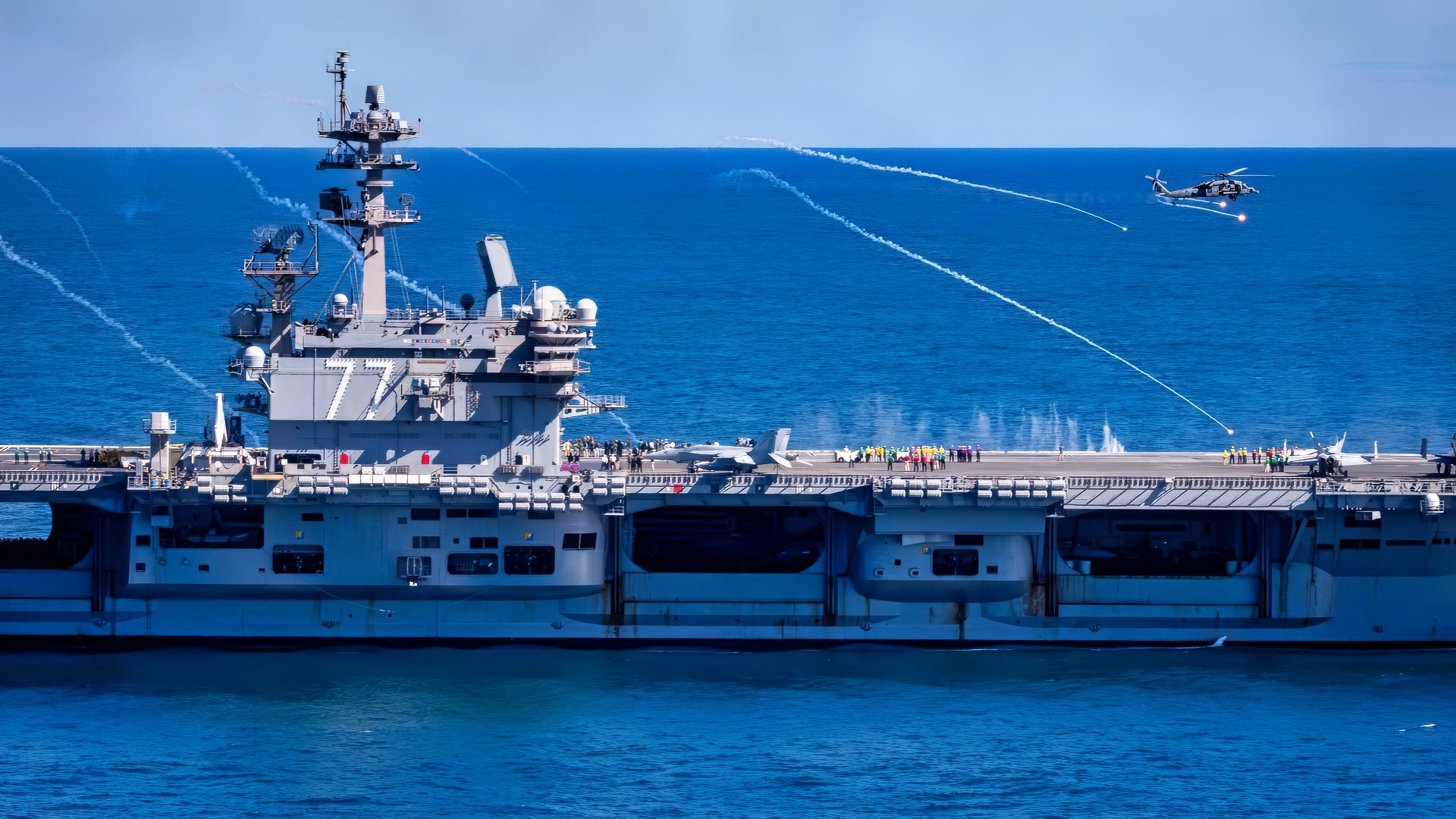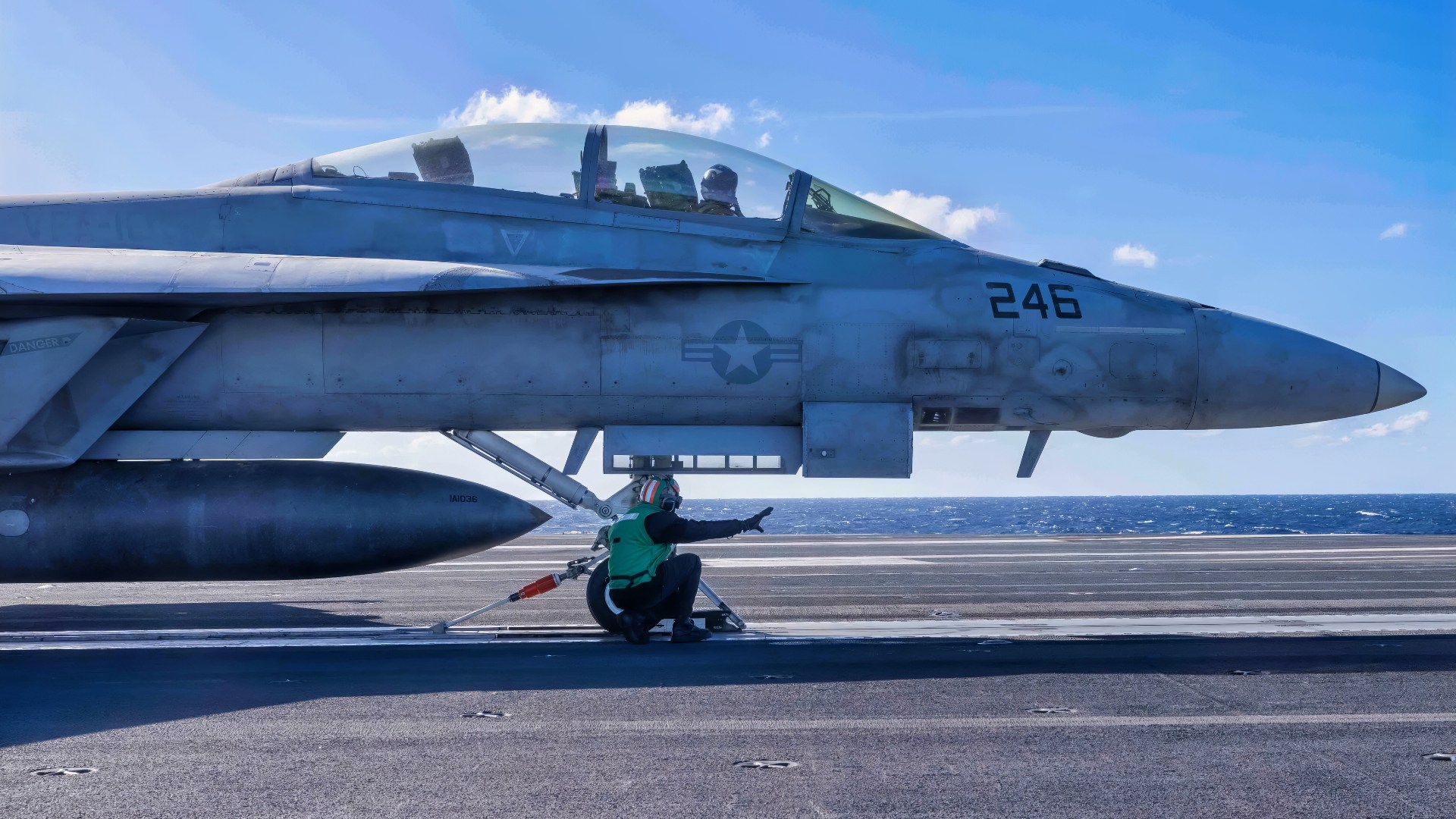Key Points and Summary – The U.S. Navy’s Future Fleet, Summed Up in One Big Shift: Smaller, Smarter, More Unmanned
-China’s growing anti-ship arsenal is forcing the U.S. Navy to rethink how it fights and survives in the Western Pacific.

(Oct. 5, 2025) An MH-60S Sea Hawk attached to the “Dusty Dogs” of the Helicopter Sea Combat Squadron (HSC) 7 fires flares above the Nimitz-class aircraft carrier USS George H.W. Bush (CVN 77) in support of the Titans at Sea Presidential Review. The Titans of the Sea Presidential Review is one of many events taking place throughout the country to showcase maritime capabilities as part of the U.S Navy’s 250th birthday. America is a maritime nation. For 250 years, America’s Warfighting Navy has sailed the globe in defense of freedom. (U.S. Navy photo by Mass Communication Specialist 2nd Class Mitchell Mason)
-Rather than betting everything on a handful of big, vulnerable surface combatants, future plans shift toward more numerous small surface ships, new amphibious vessels and a massive expansion of unmanned surface and undersea systems.
-Submarines remain central, and AUKUS will add Australian nuclear-powered boats and allied capacity to the mix, but strained U.S. shipyards are a serious bottleneck.
-The strategy is clear: a more dispersed, resilient, allied fleet designed to complicate Beijing’s targeting and outlast its missile salvos.
The U.S. Navy Has a New Playbook for Beating China’s Anti-Ship Missiles
China’s increasingly robust anti-access/area denial capabilities are well known. Designed to overwhelm and defeat America’s naval defenses, Beijing’s sophisticated anti-ship weaponry is a familiar cause for concern.
Perhaps less well understood, however, is how the United States Navy plans to adjust to once again facing a peer rival at sea — one that outnumbers the Navy in hull numbers.
America’s large surface ships are thought to be particularly vulnerable to Chinese anti-ship weaponry, the venerable aircraft carrier in particular.
Defensive measures like laser weapons have held tantalizing promise since the days of pulp comics, as have a variety of tantalizing — though not-yet-here — weaponry.
Though certainly less flashy than new, future wonder-weapons, the Navy’s plan for how to ensure victory at sea is rooted in ensuring survival.
Procurement numbers for large surface ships like the new Gerald R. Ford-class will not change, but the numbers of smaller ships that the U.S. Navy would like to acquire will increase at the expense of other large surface ships.
A Compositional Breakdown
A quick look at documentation on the U.S. Navy’s future force structure, compiled by the Congressional Research Service, a non-partisan think tank that serves American lawmakers, is insightful. The document is replete with information, but a few parts stand out. A comparison of ship force-level goals is particularly noteworthy.
In 2016, the U.S. Navy had a 355-ship goal, comprising warships, auxiliary vessels, submarines, and other naval platforms.
In 2023, that ship goal increased to 381 vessels in total. But what is most significant is the makeup of the force to get to that 381-ship goal and the difference between the 2023 and 2016 goals.
Many categories in both lists remain unchanged. The ballistic missile and attack submarine forces see no change at 12 and 66 hulls, respectively. Projected aircraft carrier numbers are also constant, at 12. However, the number of larger surface combatants, such as cruisers and destroyers, decreased by 17 hulls.
Larger amphibious assault ship numbers also dip, by 7 hulls. Other categories, however, increase.
Smaller amphibious ships, such as Medium Landing Ships, increase by 18. Small surface ships — a moniker that includes frigates — also increased by 21 hulls. But the most dramatic increase is seen in the large unmanned vehicles category, with its LUSV and MUSV (Large and Medium Unmanned Surface Vehicles), and XLUUV (Extra Large Unmanned Underwater Vehicles). Those two types of naval vessels saw a dramatic increase of 78 and 56, respectively.
A recent analysis by the RAND Corporation adds that while the U.S. Navy does have a clear incentive to use unmanned systems, “Existing concepts primarily emphasize major theater war employment. There may be other employment options, and these may require less-expensive and less-complicated unmanned systems.”
A Wrench in the Works?
The Biden Administration made waves when, seemingly out of the blue, it announced it would be sharing underwater nuclear propulsion technology with Australia, marking the first time since the late 1950s, when the United States brought the United Kingdom’s Royal Navy into the underwater nuclear fold.
Under the auspices of the admittedly awkward-named AUKUS agreement, the United States and the United Kingdom pledged to outfit the Royal Australian Navy with nuclear-powered submarines.
Crucially, however, those submarines would eschew nuclear weapons and would rely instead on conventional weaponry instead.
Though certainly a boon for the Royal Australian Navy (the new submarines will replace the RAN’s aging and problem-wracked Collins-class submarines), the move would, in effect, complicate the calculus of America’s adversaries in the Indo-Pacific.
And though nuclear-powered attack submarines built for Australia won’t be counted toward U.S. Navy fleet numbers, the RAN, Royal Navy, and U.S. Navy are right allies that work closely together and place a premium on interoperability.
Could, therefore, the Royal Australian Navy be considered almost as an extension of the American Navy? That will remain to be seen, though the added underwater tonnage is certainly good news for the United States — if it can ensure the AUKUS-class submarines to be built for its allies are produced on budget and within a reasonable timeframe.
Elbridge Colby, the Pentagon’s policy-planning czar, has questioned the logic of producing British and Australian submarines in American shipyards, if production of the foreign-operated subs slows down production of American warships and submarines.
But the AUKUS agreement provides for this possibility, thanks to billions of dollars invested by Canberra in American shipyards to expand production capacity.
Industrial base challenges will persist, regardless of Australian cash injections. As the Congressional Budget Office notes, “Over the next 30 years, the nation’s shipyards would need to produce substantially more naval tonnage than they have produced over the past 10 years. The rate of production of nuclear-powered submarines, in particular, would need to increase significantly.”
The U.S. Navy Has Big Choices Ahead
As one commentator wrote, “For industry to execute the plans in the FYDP, and therefore follow the path that provides the Navy with the capability it needs, major improvements will have to be made. The shipbuilding community has its work cut out for it.”
Though transitioning to a broader, more dispersed force posture will undoubtedly be a challenge, building many smaller vessels could be one avenue for success. Either way, the shipbuilding community will indeed have its work cut out for it.
About the Author: Caleb Larson
Caleb Larson is an American multiformat journalist based in Berlin, Germany. His work covers the intersection of conflict and society, focusing on American foreign policy and European security. He has reported from Germany, Russia, and the United States. Most recently, he covered the war in Ukraine, reporting extensively on the war’s shifting battle lines from Donbas and writing on the war’s civilian and humanitarian toll. Previously, he worked as a Defense Reporter for POLITICO Europe. You can follow his latest work on X.
More Military
The U.S. Military Purchased 2 Russian-Made Mach 2.35 Su-27 Flanker Fighters
The B-2 Spirit Stealth Bomber Has a Message for the U.S. Air Force
To The Bottom In Minutes: China Has Countless Missiles Ready to Sink U.S. Navy Aircraft Carriers










